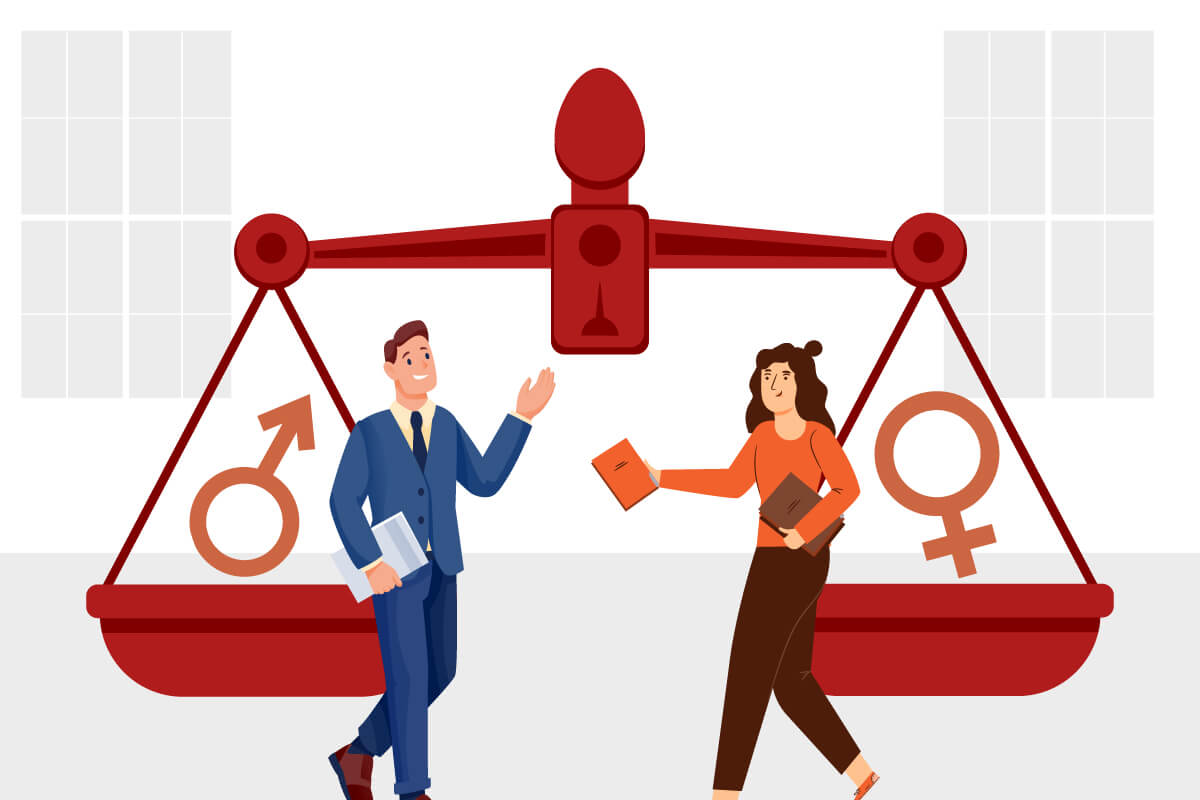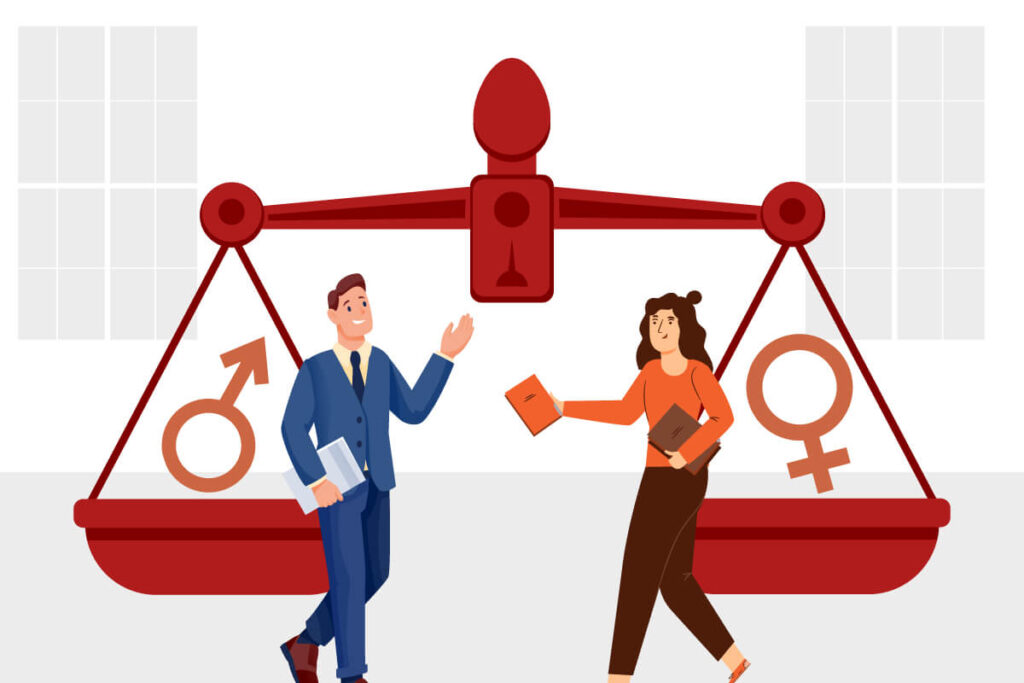Gender difference In the Workplace:
In the workplace, gender differences manifest subtly yet profoundly. Communication styles diverge, one favoring directness, the other weaving stories. Decision-making ranges from assertiveness to collaboration. Biases lurk, impacting opportunities and perceptions. Yet, amidst these contrasts lies richness and diversity. Embracing differences fosters equality, unlocking team potential. Let’s celebrate this dance, recognizing the beauty in diversity. By embracing our distinctions, we create a harmonious workplace where everyone thrives.

Male and female are the two main genders which God has created on earth as counterparts of each other each playing an equally important role on this earth. But who knew that this beautiful creation of God will be divided into unequal humans on earth making woman only a weaker and a dominated one. From ancient times women have always faced discrimination various fields whether it be work, household, living, sleeping, lifestyle, facilities where women have faced an inferior position.
We are in the 21st century using various new technologies and unbelievable devices but the ideology of discrimination and superiority of male over female has not changed so far. Yet there has been a much progress in this regard with women sharing the workplaces with men and having equality in some aspects but today also there is a disparity between the genders in workplace in terms of respect, position and money.
Gender inequality is a concept explaining the unequal treatment between males and their female counterpart. The global HDI for females is 5.90% lesser than male counterpart. South Asian region has highest disparity in HDI of women to men with women HDI’s being 16.30% lower. 25% of business entities across the globe which represent a quarter of entire business industry are operating without women in the top management position.
The research aims to evaluate the gender biasness prevailing in the workspace in India with emphasis on the corporate and the SME’s sector. The research methodology entails participatory observation collaborated with active research. The research findings provide that wide gender disparity exists in India. Conceivable reforms have been suggested in this paper for adoption at workplace so as to bridge the gender inequality gap.
As per World Economic Forum’s Global Gender Gap Report published in 2018, India ranked 108th out of 149 countries on gender gap index. According to a report by ILO means International Labour Organisation, women in India earn 65% less than their male counterparts in the same role.
Due to the growing gender pay disparity in organisations, in spite of increasing economic growth, female workforce participation is on a great declining rate of 23.6% as compared to 76.4% men. The Gender pay gap is a measure of salary received by women in relation to the men and is usually calculated by dividing women’s wages by men wages. The general methodology followed for such measurement involves year-round, full-time workers and a good level of comparison in the annual wages of the median man with median woman who form a part of this working population.
The organised sector in Indian companies comprises almost 18% of the total workforce. A large section of the working class is in the metros such as Mumbai, Bengaluru, Chennai, Delhi and Kolkata. As per available data, of the top 500 companies in the NIFTY 500 index, it was found that men earn almost 1.33 times more than the women in the private sector, and there was an even more visible difference in the prevailing salaries in the PSUs. An interesting insight from this report is a pattern in terms of the gap in salaries and pay and years of experience. It is observed that the gender pay gap increased from 5% for employees with 3-5 years of experience to about 10% for employees with experience of 6-10 years.

This gap continues to be on an increasing trend with increase in skills, with a gap of almost 20% prevailing among highly specialised skill-sets. As per the latest World Economic Forum’s (WEF) Global Gender Gap Report 2018, India ranked 108th out of 149 countries on gender gap index. Gender pay equality also functions as a vehicle of motivation, and according to the report by ILO (International Labour Organisation), women in India usually earn 65% less than their male counterparts in the same role. Due to this growing gender pay disparity in various organisations, in spite of tremendously increasing economic growth, female workforce participation is on a declining rate of just 23.6% as compared to 76.4% men.
However, if this data was to be compared with some of the developing countries around the globe, it will be significantly apparent that the pay gap in India is gradually shrinking. According to a survey conducted by an independent organisation, the gap percentage in IT services and the manufacturing sector is 24% and 26% respectively.
But when it comes to financial sector, the gap in gender pay drastically reduces to 2%. And some surveys have also report that the gender pay gap increases as the years of experience increases. For male and female, with more than 10 years of experience, the pay for men is much large than women. According to the survey reports, women executive directors earn a large 45% less than the men directors.
The facts reveal an alarming sign. While we celebrate at par with women in all deeds, it is high time that we truly appreciate and reward their work irrespective of gender. Despite the fact that we acknowledge about equality of opportunities to women in all sectors of society, we must also endorse the work rather the gender of the person.
As per Article 16 of Constitution of India, all citizens have a right to equality of opportunity in relation to the matters of public employment or appointment to any office under state. Article 38(2) strives to minimize inequalities in income among individuals and Article 39 promises equal pay for equal work for both men and women irrespective of their gender.
The Equal Remuneration Act, 1976 of India (ERA) prohibits differential pay to men and women workers for performing ‘same work or work of similar nature’. The law defines ‘same work or any work of similar nature’ which means “work in respect of which skill, effort, experience and responsibility required are same and when performed under similar working conditions by employees and if there is any difference between the skill, effort, experience and responsibility required for employees of any gender whether male or female, are not of practical importance in relation to terms and conditions of employment.
Additionally, ERA Act prohibits any discrimination between men and women workers for the same work or work of similar nature on any grounds of recruitment including promotions, training, or transfer. The Supreme Court of India has upheld constitutional validity of the principle of equal pay for equal work in its judgement. It ruled that temporary employees discharging similar duties and functions discharged as that by permanent employees is entitled to draw equal wages as that of similarly placed permanent employees.
In another landmark case, the Supreme Court held that men and women employees should be paid equally for same work or work of similar nature. The employer’s plea with respect to inability of the employer to pay similar wages to female employees was not accepted by the Court as a strong contention, as it said that the applicability of the law does not depend upon the financial ability of management to pay equal remuneration to the employees. To that extent, it ruled that the employer was in violation of provisions of the Equal remuneration Act as per law.
Recently, the Code on Wages, 2019 of India has been notified and it also received the Presidential assent on August 8, 2019. The Code of Wages consolidates 4 national level labour laws on wages, being the ERA, Minimum Wages Act 1948, Payment of Wages Act, 1936 and Payment of Bonus Act, 1965. The first set of provisions of Code of Wages relates to anti-discrimination, prohibiting discrimination against employees on ground of gender in matters relating to payment of wages.
The Code on Wages also prohibits discrimination while recruiting any employee and in conditions of employment, except in cases where employment of women in such work is prohibited or restricted under any law or act.
The key points of differential between ERA and Code on Wages are that while the ERA refers to discrimination against women and between men & women workers, the Code on Wages prohibits discrimination on the grounds of gender, thereby covering the LGBTQ category as well. The Future of Gender Pay Gap in India is based on the research and statistics; it is pertinent to note that pay disparity is one of the major indicators of issue on any kind of social injustice, which needs immediate attention. India has also taken steps to curb the pay disparity earlier.
India had previously ratified Equal Remuneration Convention, 1951 which was also adopted by the ILO. Although India has come a long way in addressing the issue of pay equity, there is a lot more to do in this field. The principle of equal pay for equal work needs to be strongly advocated, supported and promoted by the government. This should further be supported by strong wage policy and strict implementation of existing anti-disparity laws.
Since pay disparity is also noticed in India’s huge unorganised sector, it is imperative to conduct regular awareness programs among workers enlightening them about their rights. Additionally, efforts need to be made by the government to formalise the unorganised/informal sector by framing of effective wage policies applicable to them and implementation of the same for the benefit and reaching the cause of the problem.
On an international front, India is a part of G20 (Group of Twenty), which adopted certain sustainable wage policies and addressed the wage gap which has been identified as the key objectives of United Nations 2030 Agenda for Sustainable Development.
While India may be a party to various international treaties and conventions working towards eliminating wage gap, it requires active participation and a collective intent and steps to achieve the agenda. If India truly would like to project itself as a progressive nation, India should look upon this issue seriously.
India can certainly learn from smaller but more progressive countries such as Iceland, which has topped WEF ranking by closing more than 85.8% of its overall gender pay gap across the world. Hopefully, we will definitely see it included in the government’s portfolio sooner rather than later.
The major difference of leaving the job earlier by the women needs to be stopped through promoting child care centers and promoting the practice of home maids. Yet it would sound strange but the reality is that the practice would help women extract time for work and would result in a dismissal of the difference in pay based on gender.


Temp mail This is my first time pay a quick visit at here and i am really happy to read everthing at one place